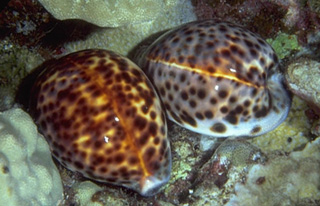
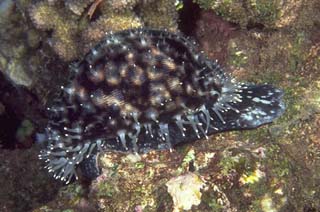
Cypraea tigris Linnaeus, 1758
Family Cypraeidae
Hawaiian waters produce the largest Tiger Cowries in the world. Although common throughout the Indo-Pacific, nowhere else do they attain such record sizes, sometimes 6 in. long. Surprisingly, these cowries were not officially recorded from Hawai`i until the 1930s. Dr. C.M. Burgess writes: "The first living specimen...was collected by the late Ted Dranga and Ditlev Thaanum in June, 1936.... The shell was seen in eighteen feet of water. Dranga dived for it and got it. The slippery beauty oozed from Mr. Thaanum's hands and Ted had the pleasure of diving for it a second time." The larger size Tiger Cowries, extraordinarily beautiful, are now difficult to find. Although the pattern is simple, white with dark spots, the varying number and size of the spots can produce shells ranging from very light to almost solid black. It is said that no two are alike. The mantle is mottled dark gray with long, pointed, white-tipped papillae. This cowry is more likely to be seen by day than many others, probably because it is too big to hide effectively. In Hawai`i it usually occurs below about 10 ft. Elsewhere in the Indo-Pacific it ranges also into the intertidal. The species name denotes any of the large cats, many of which (like leopards) are spotted. Photo: a) Molokini Islet, Maui. 30 ft. b) south shore, Lana`i, 25 ft. (mantle extended)
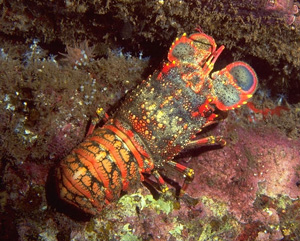
REGAL SLIPPER LOBSTER •
ula-papapa
Arctides regalis Holthuis, 1963
Family Scyllaridae
Before the advent of scuba this colorful
and rather common lobster was considered rare. The antennae consist of
flattened gray-blue plates, bright red at the periphery and equipped with
a few forward-pointing, yellow-tipped spines. The rough gray carapace
is covered with tubercles, some tipped with red or yellow. The beautifully
sculptured tail segments are primarily orange-red. The legs are banded
yellow and orange. Although appearance alone might justify the name "regal,"
the species is named for Mary Eleanore King, a passionate shell collector
active for many years in Honolulu. "Mariel" King sponsored a
number of scientific expeditions in her research vessel Pele, making substantial
contributions to Pacific marine zoology. The first scientific specimen
of this lobster was collected near Moku o Lo`e (Coconut Island), Kane`ohe
Bay, O`ahu. Known also from Easter Island, New Caledonia, and Réunion,
it appears to prefer cooler waters at the edges of the tropics (a pattern
of distribution common to many Hawaiian marine animals and known as "antitropical").
To about 7 in. Indo-Pacific. Photo: Palea Point, O`ahu. 40 ft.
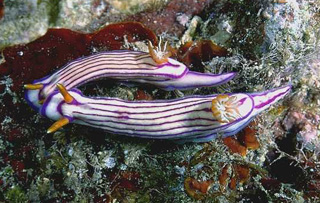
Hypselodoris maridadalus Rudman, 1977
Family Chromodorididae
Nudibranchs of the genus Hypselodoris are often marked with longitudinal lines; this slug is a good example. Parallel magenta stripes run the length of its delicate white body. The rhinophores and gills are orange. The species was described from East African specimens and given the Swahili name "maridadi," meaning "beautiful." In Hawai`i it is known primarily from the boat channel at Magic Island, O`ahu, where it is occasionally seen by day crawling in the open. It ranges from East Africa to Hawai`i. To about 1 in. Photo: Magic Island boat channel, O`ahu. 15 ft.
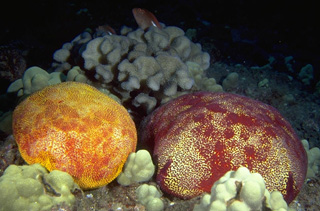
Culcita novaeguineae (Müller & Troschel, 1842)
Family Oreasteridae
Fully grown Cushion Stars resemble plump, bristly, pentagonal cushions about 10 in. across and 3 to 4 in. thick at the center. They may be red, maroon, tan or yellow. Although adults have no obvious arms, five colorful rows of tube feet radiate from the central mouth on the underside. These stars feed on living coral by everting their stomachs (a colorless gelatinous mass that quickly retracts when the animal is disturbed) and digesting the polyps where they grow. In Hawai`i they prefer small colonies of Pocillopora meandrina and P. damicornis, which they often kill completely. They attack other corals too. Their bristly surface is frequently home to Periclimenes soror (p. 224), a tiny commensal shrimp that matches the color of its host. If turned upside down, a Cushion Star is able to right itself by inflating one side of its body with water, arching over to get a grip with its tube feet, and pulling itself over. Very small specimens are flat with five stubby arms and resemble star-shape Christmas cookies. To about 10 in. across. Indo-Pacific. Photo: "Five Graves," Kihei, Maui. 30 ft.